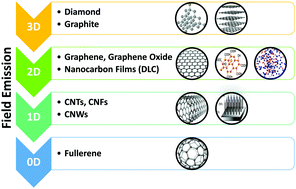The rise of carbon materials for field emission
Abstract
Carbon-based materials exhibit distinct structures and dimensionality which allow modification of their electrical properties and enable them to be integrated in various commercial systems. One of the interesting characteristics of carbon-based materials is efficient electron field emission (FE), which makes them good candidates for displays, in electron microscopy, lithography, sensing, micro- and nanoelectronics, X-ray sources and medical applications. While nano carbon materials have been extensively studied for FE applications, their usefulness, electron emission concerns, and fundamental mechanisms for FE technologies are buried in the reported literature, and cross comparison of all nano carbon materials together is rarely explored. Here we present a comprehensive overview of fundamental and FE properties of all carbon-based materials including diamond, nanocrystalline diamond, graphite, carbon nanotubes, carbon nanofibers, carbon nanowires, carbon nanorods, graphene, and amorphous and nanostructured carbon. Some of these carbon materials, such as amorphous and nanostructured carbon, possess the added benefit of room temperature production over large areas on a variety of substrates. We have compiled an up to date summary which critically discusses the material factors, and the factors that control electron emission of these materials. We also propose unique ideas to further improve electron emission for the design of energy efficient carbon-based cold cathode materials for next generation large area electronic devices.



 Please wait while we load your content...
Please wait while we load your content...